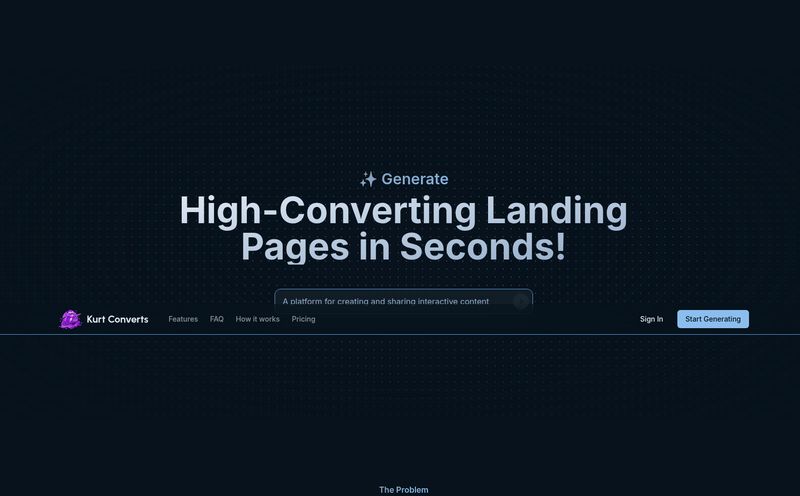If you've been in the SEO or blogging world for more than a minute, you know the grind. The constant, nagging pressure to publish. More content. Better content. Content that ranks. Content that engages. It's a relentless treadmill, and some days, it feels like you're sprinting just to stay in the same place.
I've spent years juggling keyword research, client reports, technical audits, and the ever-present demand for fresh blog posts. I've tried outsourcing to freelancers (with mixed results) and I've stared at a blinking cursor on a blank Google Doc more times than I care to admit. So when another AI writer pops onto my radar, my first reaction is usually a healthy dose of skepticism mixed with a tiny, hopeful whisper of... what if?
That's exactly where I was when I started messing around with Article Fiesta. It promises to create “amazing SEO content 10X faster with AI.” Big claim. But I’ve learned not to dismiss things out of hand in this industry. So I grabbed a coffee, plugged in a few keywords, and decided to see if it was just another cog in the AI hype machine or something genuinely useful.
So What Is Article Fiesta Anyway?
At its core, Article Fiesta is an AI-powered article generator. You give it a keyword, and it spits out a full-length, SEO-optimized article. But that's a bit of an oversimplification. The platform tries to be more of a complete content solution, not just a word spinner. It automatically adds royalty-free images, builds internal links between your posts, writes a meta description, and even structures a FAQ section with the proper schema. It’s designed to take you from a single keyword to a ready-to-publish blog post with minimal fuss.
Think of it less like a ghostwriter and more like a super-efficient junior content assistant. The one who handles all the tedious bits so you can focus on the big picture strategy.

Visit Article Fiesta
The Standout Features That Caught My Eye
I’m a features guy. I like to pop the hood and see what makes a tool tick. A lot of AI writers are basically just fancy wrappers for an API, but Article Fiesta has a few built-in functions that show they're thinking specifically about the needs of bloggers and website owners.
The All-in-One SEO Package
This isn't just about keyword density. The tool claims to handle a bunch of on-page SEO tasks automatically. It generates a meta description (a solid time-saver) and creates a FAQ section with the correct schema markup. For anyone who's manually coded FAQ schema, you know how fiddly that can be. Having a tool that does it automatically is a nice touch and can help you snag those rich snippets in Google's search results.
Internal Linking on Autopilot? Yes, Please.
This was the feature that really made me lean in. Building a smart internal linking structure is one of the most underrated SEO tactics out there. It helps Google understand your site architecture, spreads link equity, and keeps readers on your site longer. But it's also incredibly tedious to do manually, especially on a large site. Article Fiesta promises to scan your existing content and automatically add relevant internal links to the new articles it creates. If it works as advertised, that’s a huge win.
From Generation to Live Post in a Few Clicks
The workflow is another strong point. The platform can directly connect to your WordPress, Ghost, or Shopify blog and post the article for you. It even sources and inserts relevant, royalty-free images. This removes several boring steps from the publishing process—no more downloading, resizing, uploading, and formatting images. It's all about reducing friction and getting content live faster. Speed is a competitive advantage, after all.
My Honest Take: The Good, The Bad, and The AI
Alright, no tool is perfect. Let's get down to brass tacks. After running a few articles through the system, here's my unfiltered take.
The biggest pro is, without a doubt, the speed. The time saved is phenomenal. You can generate a first draft of a 1500-word article in minutes, not hours. For agencies needing to produce content at scale or solo bloggers trying to build topical authority, this is a game-changer. The plagiarism-free guarantee and the included images are also massive pluses, solving two common content headaches in one go.
Now, for the reality check. The quality can be... variable. For a broad keyword, the AI might produce a fantastic, well-structured article. But for a highly-niched or complex topic, it can sometimes miss the mark or sound a bit generic. You still need a human hand for the final polish, to inject your unique voice, and to fact-check anything that seems off. You can't just blindly hit 'publish' and expect perfection. This isn't a replacement for a skilled writer; it's a tool to make that writer incredibly efficient.
I also felt a slight loss of creative control. I'm a hands-on kind of SEO, and sometimes the AI's interpretation of a keyword wasn't quite what I had in mind. It's a trade-off: you sacrifice some control for a massive gain in speed and efficiency. For many, that trade-off will be well worth it.
Let's Talk Money: A Look at Article Fiesta's Pricing
So, what's this going to cost you? The pricing structure is pretty straightforward and tiered based on the number of articles you need per month. I appreciate that they don't hide their prices behind a “Contact Us” wall (for the most part).
| Plan | Price | Articles/Month | Best For |
|---|---|---|---|
| Basic | $19.99 /mo | 5 | Hobby bloggers or those just starting out. |
| Growth | $39.99 /mo | 15 | Serious bloggers and small business owners. |
| Pro | $59.99 /mo | 30 | Power users or small agencies. |
| Enterprise | $299.99 /mo | 300 | Content-heavy businesses and larger agencies. |
For my money, the Growth or Pro plan seems to hit the sweet spot for most serious individual users. Fifteen to thirty articles a month is a significant amount of content that can really move the needle on a site’s traffic. The money-back guarantee also lowers the barrier to entry—it shows they have confidence in their product.
Frequently Asked Questions About Article Fiesta
I had some questions myself, and these are the ones that pop up most often when discussing tools like this.
Who actually owns the written content?
You do. Once the article is generated, you have full ownership. You can edit it, publish it, and use it however you see fit. This is standard for most reputable AI writers and a critical point.
Is this just another ChatGPT interface?
This is a fair question in today's market. According to their site, they use their own fine-tuned models on top of existing AI technology. The real value isn't just the text generation, but the entire workflow—the SEO optimization, image integration, internal linking, and direct posting. That's the stuff that separates it from just having a ChatGPT tab open.
What's the quality really like for academic or technical writing?
I'd be cautious here. Like most broad AI tools, it excels at general topics. For highly specialized, technical, or academic content that requires deep subject matter expertise, you will absolutely need a human expert to write or at least heavily edit the output. Don't expect it to write a peer-reviewed paper for you.
Can I cancel my subscription at any time?
Yes. Their pricing page indicates you can cancel anytime, which is the flexibility you want to see in a SaaS tool.
Final Thoughts: Is Article Fiesta Worth a Shot?
So, what’s the final verdict? Is Article Fiesta the magic bullet for all your content woes? No, of course not. No tool is.
But is it a powerful, well-designed assistant that can take a huge amount of tedious work off your plate, freeing you up to focus on higher-level strategy? Absolutely. For affiliate marketers, niche site builders, agencies, and bloggers who understand the value of producing content consistently, this tool could be a massive force multiplier.
The key is to use it smartly. Use it to generate solid first drafts. Use it to smash through writer's block. Use it to handle the boring stuff like finding images and adding basic SEO elements. Then, come in with your human expertise and personality to add that final 10-20% of polish that separates good content from great content. If you approach it with that mindset, I think you’ll be pleasantly surprised.



